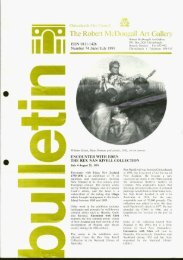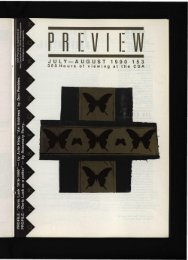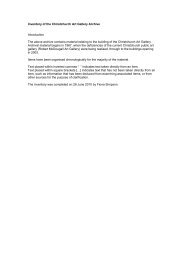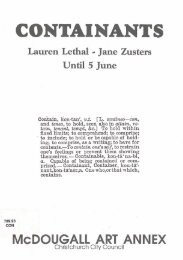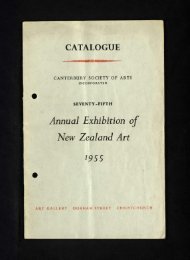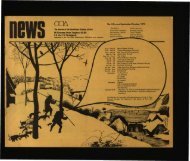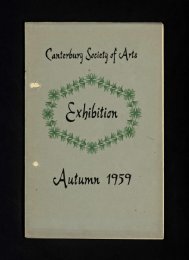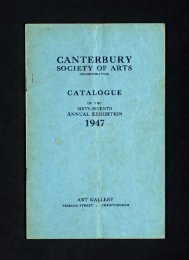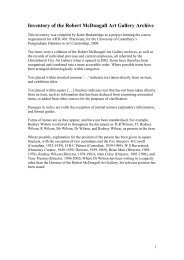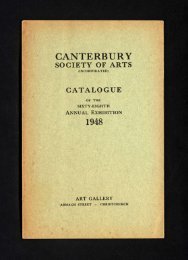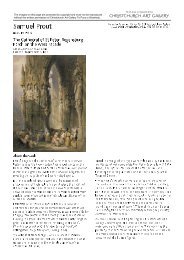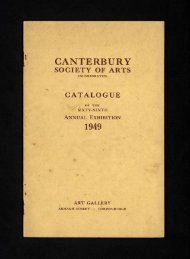Download (2.2 MB) - Christchurch Art Gallery
Download (2.2 MB) - Christchurch Art Gallery
Download (2.2 MB) - Christchurch Art Gallery
You also want an ePaper? Increase the reach of your titles
YUMPU automatically turns print PDFs into web optimized ePapers that Google loves.
Alan Loney printing at the Hawk Press, Taylors Mistake in 1976. Photograph by Robin Neate<br />
ALAN LONEY: Poet & Printer<br />
5 SEPTE<strong>MB</strong>ER – 28 SEPTE<strong>MB</strong>ER<br />
To help celebrate the <strong>Christchurch</strong> Writers' Festival, the<br />
<strong>Gallery</strong> is holding an exhibition of hand-printed books by<br />
Alan Loney – a man at the forefront of letterpress printing<br />
in Australasia and this year’s printer-in-residence at the<br />
University of Otago’s Otakou Press. Loney has honed his<br />
skills as a designer, typographer and printer in collaboration<br />
with poets and artists since the 1970s, leaving a rich legacy of<br />
hand-printed books. He is also an established and respected<br />
poet and has published several collections of poetry.<br />
Loney’s work as a letterpress printer began in <strong>Christchurch</strong><br />
in the humble surroundings of an old garage overlooking<br />
Taylors Mistake, where he established the Hawk Press in<br />
1975. These were somewhat romantic beginnings – the<br />
printer working by the light of a kerosene lamp on what would<br />
ultimately become important volumes of poetry by, among<br />
others, Ian Wedde, the American poet Robert Creeley and<br />
Loney himself, in a space with breathtaking views overlooking<br />
Taylors Mistake and Pegasus Bay beyond. It was here that<br />
Loney’s long and creative journey as a printer began; one that<br />
has seen him printing in Wellington, Auckland and, more<br />
recently, Melbourne, where he established his latest press,<br />
Electio Editions, in 2004. Over time Loney has become ever<br />
more conscious of printing books to the highest quality, using<br />
only the finest papers, inks and bindings to produce some of<br />
the most exquisite books in Australasia.<br />
The exhibition covers Loney’s printing career from 1975<br />
to the present, and includes books published by Hawk Press,<br />
Black Light Press, Holloway Press and Electio Editions. These<br />
books highlight Loney’s carefully honed skills and mastery of<br />
letterpress printing, as well as his collaborative relationship<br />
with poets and artists such as Ian Wedde and Ralph Hotere,<br />
Robin Neate, Joanna Margaret Paul, Bill Manhire and Andrew<br />
Drummond, Ted Jenner and John Reynolds, Robert Creeley<br />
and Max Gimblett.<br />
Peter Vangioni<br />
Curator<br />
Alan Loney: Poet & Printer opens on the balconies on 5 September.<br />
Staff Profile<br />
The Curatorial Team<br />
Conservators conserve, framers frame, installers install, and<br />
curators … well, what is it exactly that curators do? People<br />
often ask, and, for many of them, the word ‘curator’ seems to<br />
suggest someone tweedy and bookish snuffling round in a dark<br />
storeroom – a fusion, perhaps, of ‘curate’ and ‘caretaker’. That<br />
cliché has had some competition in recent years from the image<br />
of the curator as an Armani-clad orchestrator of mega-shows,<br />
racking up airpoints on the international art circuit.<br />
I hope I’m not disappointing anyone when I say this,<br />
but neither stereotype appears to be thriving here in the east<br />
wing of the <strong>Christchurch</strong> <strong>Art</strong> <strong>Gallery</strong>, where the <strong>Gallery</strong>’s<br />
five curators all work.<br />
What do we do here? Despite the evidence of the<br />
photograph below, we don’t spend a lot of time standing<br />
around striking poses in exhibition galleries. If you find us in<br />
the galleries, we’re more likely to be talking about artworks,<br />
or looking at them, or making nervous requests – ‘up slightly,<br />
a little to the left’ – while a new exhibition is being hung.<br />
Although there are now courses and indeed whole institutions<br />
devoted to training curators, one of the pleasures of being<br />
a curator in New Zealand is that the role is still open and<br />
interestingly various. In any given week, a curator may be part<br />
critic, part collector, part fundraiser, part lobbyist, part studio<br />
visitor, part researcher, part writer, and part fan.<br />
At all times, though, the aim is to put the art at the heart<br />
of the equation. That means offering explanations, of course;<br />
those little patches of text called wall labels are one of the<br />
obvious ways in which curators try to drop a few hints and<br />
enlarge the conversation. But it also means knowing when to<br />
stop explaining and leave viewers to unfold the art on display<br />
in their own time and mental space. And since nothing a wall<br />
label offers can compete with a powerful point made visually,<br />
it means locating the very best artworks for the collection,<br />
and placing them beside each other in ways that amplify<br />
their meanings.<br />
One way to answer the big question ‘What do curators<br />
do?’ is to ask the smaller question, ‘What are these curators<br />
doing at the moment?’ For Peter Vangioni, the current<br />
interest – no, he corrects me, it’s officially an obsession – is<br />
Petrus van der Velden’s mighty series of paintings depicting<br />
Otira Gorge. Nearby, Felicity Milburn is scrolling through<br />
a screen full of dreamscapes and haunting self-portraits by<br />
Séraphine Pick – the subject of a survey and major book here<br />
in mid-2009. Across the hallway, Jennifer Hay is just about to<br />
head to Auckland to talk with several artists about creating<br />
new works for her young contemporaries show in December.<br />
And Ken Hall is unlocking some startling details about the<br />
<strong>Gallery</strong>’s ‘gentleman in red’, which you can discover for yourself<br />
by turning to page 26. The most enjoyable distraction on my<br />
own desk is a tabletop model of a forthcoming exhibition<br />
called Wunderbox.<br />
Today the word curator is under threat from jargon<br />
job-titles like ‘concept developer’. I hope they never catch<br />
on here. ‘Developer’ sounds to me like someone who has<br />
just perpetrated a new shopping mall. ‘Curator’ has a richer<br />
genealogy. Follow it back to its Latin roots in the language<br />
and you’ll come to a good word: ‘care’.<br />
Justin Paton<br />
Senior Curator<br />
From left: Ken Hall (assistant curator), Peter Vangioni (curator), Justin Paton (senior curator), Felicity Milburn (curator), Jennifer Hay (assistant curator)<br />
38 39



